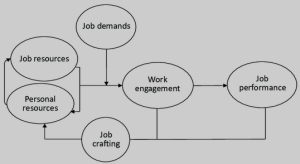The Job Demands-Resources (JD-R) model is a theoretical framework that examines the impact of job demands and resources on employee well-being. This model suggests that job demands and resources play distinct roles in influencing various aspects of well-being.The purpose of this study is to assess the impact of job demands and resources on employee well-being:

The Impact of Job Demands and Resources on Employee Well-being
Table of Contents
ToggleJob Demands:
- Definition:
- Job demands refer to the physical, psychological, social, or organizational aspects of a job that require sustained physical or mental effort and are associated with certain physiological and psychological costs.
- Impact on Well-being:
- Excessive job demands, such as high workload, time pressure, or role ambiguity, can lead to stress, burnout, and decreased well-being.
- Prolonged exposure to high demands without adequate resources can contribute to physical and mental health issues.
- Potential Negative Outcomes:
- Burnout: Chronic exposure to high job demands can lead to burnout, characterized by emotional exhaustion, depersonalization, and reduced personal accomplishment.
- Job Strain: High demands without sufficient resources may contribute to job strain, negatively affecting both mental and physical health.
Job Resources:
- Definition:
- Job resources are aspects of the job that may help employees achieve work goals, reduce job demands, and stimulate personal growth and development.
- Impact on Well-being:
- Adequate job resources contribute to employee well-being by buffering the negative impact of job demands. They provide the support and tools necessary to cope with challenges.
- Potential Positive Outcomes:
- Increased Job Satisfaction: Resources such as autonomy, feedback, and social support can enhance job satisfaction and overall well-being.
- Employee Engagement: Resources that promote skill variety, task identity, and task significance can contribute to higher levels of employee engagement.
- Examples of Job Resources:
- Social Support: Colleague and supervisor support can act as a resource, reducing the negative impact of stressors.
- Autonomy: Having control over one’s work and decision-making can be a resource that enhances well-being.
- Feedback and Recognition: Regular feedback and recognition contribute to a positive work environment.
Interaction Between Demands and Resources:
- Buffering Effect:
- Resources can act as buffers against the negative impact of job demands. For example, social support may help employees cope with high workload or job pressure.
- Spiral Effect:
- Positive resources can initiate a positive spiral, leading to increased well-being. For instance, job satisfaction and engagement resulting from resources can enhance an employee’s capacity to cope with demands.
Practical Implications:
- Workplace Interventions:
- Organizations can implement interventions to reduce job demands, such as workload management strategies, and enhance resources, such as training programs and support networks.
- Job Design:
- Optimizing job design to include aspects like task variety, autonomy, and feedback can contribute to a healthier work environment.
- Employee Development:
- Investing in employee development, training, and opportunities for skill enhancement can provide resources that contribute to well-being.
- Leadership Practices:
- Supportive leadership practices, such as providing clear expectations, offering feedback, and fostering a positive work culture, can act as resources for employees.
- Flexible Work Arrangements:
- Providing flexibility in work arrangements can be a resource that helps employees manage their work demands and personal responsibilities.
Understanding the interplay between job demands and resources is essential for organizations seeking to create a work environment that promotes employee well-being. Balancing demands and resources contributes to a healthier, more engaged, and more satisfied workforce.
